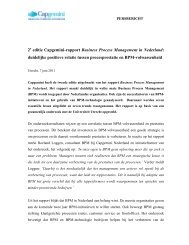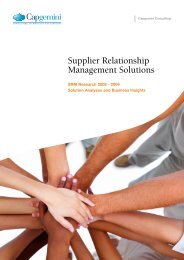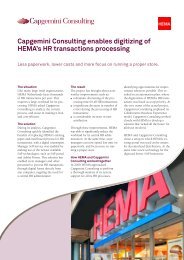IT transformations - Capgemini Consulting Nederland
IT transformations - Capgemini Consulting Nederland
IT transformations - Capgemini Consulting Nederland
Create successful ePaper yourself
Turn your PDF publications into a flip-book with our unique Google optimized e-Paper software.
Figure 4:<br />
High<br />
Level of Functionality*<br />
Low<br />
Low<br />
Maturity Matrix for COTS Solutions<br />
Analytical<br />
CRM<br />
Data<br />
Warehouse<br />
Customer Care<br />
Service<br />
Fulfillment<br />
Operator Adoption<br />
ERP<br />
Centralized<br />
Product Catalog<br />
Service<br />
Assurance<br />
Billing<br />
High<br />
Size of the bubble<br />
indicates<br />
“Vendor Focus”<br />
In the next section, we take a look at<br />
the building blocks of a successful <strong>IT</strong><br />
transformation program.<br />
Building Blocks of a Successful<br />
Business Transformation<br />
In order to respond to the rapid<br />
environmental changes in the<br />
industry, operators need to revisit<br />
their <strong>IT</strong> strategy. The changing<br />
business environment requires<br />
operators to make key changes in<br />
their processes and <strong>IT</strong> architecture.<br />
In this section we discuss the main<br />
building blocks of an <strong>IT</strong> renewal<br />
program (see Figure 5).<br />
* Level of functionality: Indicative of functionality provided by Amdocs, Oracle, Comverse, Convergys, SAP and Ericsson<br />
products<br />
Source: <strong>Capgemini</strong> Analysis; Company Websites; TM Forum Website<br />
Planning (ERP) have reached a high<br />
degree of maturity in terms of the<br />
level of functionality provided by<br />
different vendors and adoption by<br />
various operators (see Figure 4).<br />
For instance, billing solutions from<br />
various vendors today cover all<br />
aspects of rating, mediation and<br />
partner settlement.<br />
However, the market still lacks the<br />
availability of complete suites of<br />
various BSS/OSS components from<br />
a single vendor, driving operators to<br />
prefer best-of-breed solutions that<br />
combine components from different<br />
vendors. Consequently, some vendors<br />
including Amdocs and Oracle are<br />
now focusing on developing end-toend<br />
solutions providing all BSS and<br />
OSS components required by the<br />
operators.<br />
Considering these evolutions, most<br />
operators are embarking on <strong>IT</strong><br />
transformation programs. However,<br />
in these implementations the main<br />
challenge is to create a comprehensive<br />
business plan and business case,<br />
besides addressing the <strong>IT</strong> complexity<br />
that is required to manage in the<br />
course of the transformation.<br />
<strong>IT</strong> architecture and solution<br />
implementation<br />
<strong>IT</strong> architecture and solution<br />
implementation is an important<br />
component in the assessment of the<br />
readiness for a transformation. It<br />
provides the key interaction point<br />
and alignment with the roadmap<br />
of the <strong>IT</strong> integrator. Key readiness<br />
aspects that need to be in place in<br />
order to perform an efficient and<br />
effective <strong>IT</strong> release process need to<br />
be defined beforehand. This includes<br />
synchronized roadmaps between<br />
business and <strong>IT</strong>, where each step in<br />
the <strong>IT</strong> transformation phase generates<br />
true business value. Furthermore<br />
the process should ensure that all<br />
the stakeholders are aligned on a<br />
common platform.<br />
Business architecture and processes<br />
The rationale behind the creation<br />
of the business architecture and<br />
processes stream is the need to<br />
prioritize the area where the bulk<br />
of the delivery work will need to be<br />
performed during the transformation.<br />
The different elements that need to<br />
be designed are: scoping and defining<br />
the business requirements approach,<br />
business process re-engineering based<br />
upon the best-of-suite processes,<br />
business data management and<br />
metrics and Key Performance<br />
Indicators (KPIs).<br />
60
















